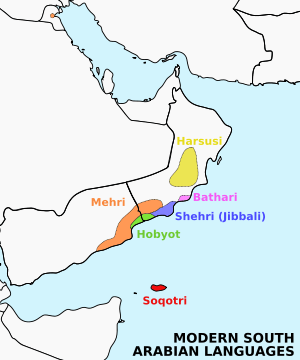Harsusi language
Harsusi (Arabic: لغة حرسوسية also known as Ḥarsūsī, Harsiyyet, Hersyet, or Harsi `Aforit) is a Semitic language of Oman, spoken by the Harasis people. It is classified as a moribund language,[4] with an estimated 600-1000 speakers in Jiddat al-Harasis, a stony desert in south-central Oman. It is closely related to Mehri.[5]
| Harsusi | |
|---|---|
| Harsiyyet | |
| Pronunciation | [ħarsuːsi][1] |
| Native to | Oman |
| Region | Jiddat al-Harasis, Dhofar Province |
Native speakers | 600 (2011)[2] |
| Language codes | |
| ISO 639-3 | hss |
| Glottolog | hars1241[3] |
 | |
General information
Harsusi first came to the attention of outside scholars in 1937, when it was mentioned by Bertram Thomas in his book Four Strange Tongues of South Arabia.[4] While certain scholars have claimed that Harsusi is a dialect of the more widely spoken Mehri language,[6] most maintain that they are mutually intelligible but separate languages .[5] Harsusi, like all the Modern South Arabian languages, is unwritten,[4] though there have been recent efforts to create a written form using an Arabic-based script.[7]
Because the Harasis people were for centuries the only human inhabitants of Jiddat al-Harasis, the language developed in relative isolation.[8] However, as most Harasis children now attend Arabic-language schools and are literate in Arabic, Harsusi is spoken less in the home, meaning that it is not being passed down to future generations.[4] Though the discovery of oil in the area and the conservation project for the re-introduced oryx herd have provided many job opportunities for Harsusi men,[5] these factors have also caused many Harasis to speak Arabic and Mehri in addition to or in place of Harsusi. These pressures led one researcher to conclude in 1981 that "within a few generations Harsusi will be replaced by Arabic, more specifically by the Omani Arabic standard dialect"[9] though this has not yet materialized.
UNESCO has categorised Harsusi as a language that is "definitely endangered".[10]
Phonology
Consonants
| Labial | Dental | Lateral | Post- alveolar |
Velar | Pharyngeal | Glottal | |||
|---|---|---|---|---|---|---|---|---|---|
| central | sibilant | ||||||||
| Nasal | m | n | |||||||
| Plosive | voiceless | t | k | ʔ | |||||
| voiced | b | d | ɡ | ||||||
| glottalized | tʼ | kʼ | |||||||
| Fricative | voiceless | f | θ | s | ɬ | ʃ | x | ħ | h |
| voiced | ð | z | ɮ | ɣ | (ʕ) | ||||
| glottalized | ðʼ | sʼ | ʃʼ | ||||||
| Rhotic | r | ||||||||
| Semivowel | l | j | w | ||||||
The pharyngeal consonant /ʕ/ only exists possibly because of the influence of Omani Arabic.
Vowels
| Front | Central | Back | |
|---|---|---|---|
| Close | i iː | u uː | |
| Mid | e eː | ə | o oː |
| Open | a aː |
In more open syllables /ə/ is realized as /ʌ/.
Diphthongs may be realized as ay /æj/ and aw /ɑw/.
References
- Harsusi at Ethnologue (19th ed., 2016)
- Hammarström, Harald; Forkel, Robert; Haspelmath, Martin, eds. (2017). "Harsusi". Glottolog 3.0. Jena, Germany: Max Planck Institute for the Science of Human History.
- Morris, M. 2007. "The pre-literate, non-Arabic languages of Oman and Yemen. Archived 2015-03-08 at the Wayback Machine" Lecture conducted from Anglo-Omani and British-Yemeni Societies.
- Peterson, J.E. "Oman's Diverse Society: Southern Oman." In: Middle East Journal 58.2, 254-269.
- Maisel, S., and Shoup, J. 2009. Saudi Arabia and the Gulf Arab States Today: An Encyclopedia of Life in the Arab States. Westport, Conn.: Greenwood Press.
- Eades, D. "The documentation and ethnolinguistic analysis of Modern South Arabian: Harsusi." Endangered Languages Archive.
- Chatty, D. 2013. “Negotiating Authenticity and Translocality in Oman: The 'Desertscapes' of the Harasiis Tribe.” In S. Wippel (ed.). Regionalizing Oman 6, 129-145. Springer Netherlands.
- Swiggers, P. 1981. “A Phonological Analysis of the Ḥarsūsi Consonants.” In: Arabica 28.2/3, 358-361.
- United Nations Educational, Scientific and Cultural Organisation (UNESCO), "Atlas of the World's Languages in Danger", 2010.
Further reading
Chatty, Dawn (2001). "Adapting to Multinational Oil Exploration: The Mobile Pastoralists of Oman". Differenz und Integration. 1 (2): 1–19.
Johnstone, Thomas M. (1977). Ḥarsūsi Lexicon and English-Ḥarsūsi word-list. London: Oxford University Press.
Simeone-Senelle, Marie-Claude (1997). "The Modern South Arabian Languages" (PDF). The Semitic Languages: 378–423.
Stroomer, Harry (2004). Harsusi Texts from Oman: Based on the Field Materials of T. M. Johnstone. Wiesbaden: Otto Harrassowitz. ISBN 3447050977.
Thomas, Bertram (1937). Four Strange Tongues from South Arabia: The Hadara Group. H. Milford.
External links
- Ethnologue
- ELAR archive of Harsusi language documentation materials